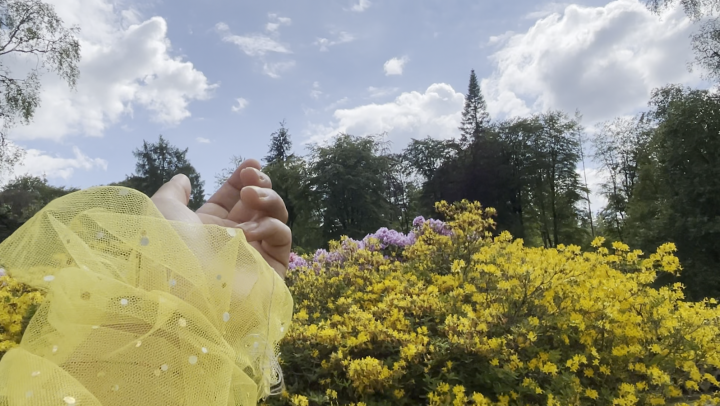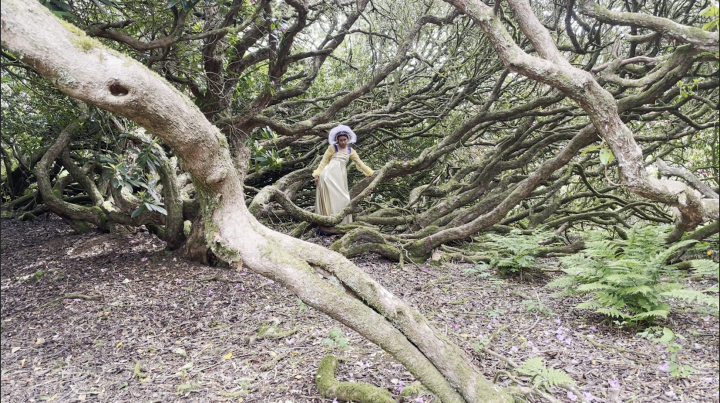Scottish Art News
Latest news
Magazine
News & Press
Publications
Empire of Joy
By Greg Thomas, 01.08.2022

Saoirse Amira Anis loves to dance. At one point in ‘A Lesson in Vanity’ (2021), a film playing downstairs at Cample Line, she breaks out into an infectious shimmy, complete with air‐drum solo, while seated on a step making a purple paper crown. Anis is later seen smugly donning the frilly hat while observing herself side‐on in a bedroom mirror, lines from a trembly rendition of the African‐American spiritual Down in the River to Pray (“and who shall wear the starry crown...”) ringing softly in the background. When this video was made, Anis was still developing her persona of Freedom Princess – “my name, ‘Saoirse Amira’ translates from Irish Gaalic and Arabic to Freedom Princess,” she tells us in an interview accompanying the show – and we sense a moment of transformation or consummation. The joy of physical movement for its own sake is briefly embraced although the artist is not yet dressed in royal regalia.
A Lesson in Vanity offers us “an insight into Freedom Princess’s first princess lesson,” namely that “vanity is a vital aid to nature: completely and absolutely necessary to life.” By the end of the fairytale‐like narrative, our protagonist has learned, “only to hide that which she holds sacred, not that which feels shameful.” The film and its 2022 follow‐up ‘A Lesson in Frivolity’ – which runs upstairs in an intimate, chapel‐like space, bathed in lavender light behind a tie‐dyed purple curtain, complete with customised pew – show the princess cavorting in the great outdoors, from ornamental gardens to the roots of giant trees and an Italian bay bathed in sunlight. At one point she wades out into calm Mediterranean waters, as if heading down in the river to pray, or to partake in some secular baptism.
Cheryl McGregor notes in Art Thou that “performance art...is a fairly recent development in Anis’s practice which, in the halcyon days of art school, leaned more towards sculpture and photography.” The former medium in fact remains a central tenet of her work. Adjacent to the sanctum‐like viewing room just described is a scattering of hand‐moulded ceramic curios, found objects, hanging fabrics, and paintings: talismans for the Princess’s radical power of self‐worship. All are done up in the purple‐and‐yellow colour scheme Anis has chosen for her monarchical avatar. “Purple is this in‐between colour. It stands in for queerness and otherness, [but] it was also associated with royalty,” she states in her exhibition interview. She also describes her Scottish‐Malian‐Moroccan heritage as an influence on the Princess’s imperial burlesque: “each of the countries to which I am connected has some history of being oppressed and oppressor.”
The lapsed‐Catholic iconography of this work – another subtext raised in interview – is as clear as the hints of titles such as ‘In Place of an Altar’. Concave aluminium frames daubed in gold leaf (‘Primordial Perfection’) and shelves of votive trinkets are arraigned like icons across the walls. ‘The Font of Holy Joy’ invites us to bless ourselves with lavender‐scented water: an exaltation of the here and now, of the sensory pleasure to be found within it. The outer forms of Christian ritual are wrung free of their associations with guilt and masochism. Little shiny pieces of pottery bear the imprints of fingers: the body is celebrated through this work.
 Still from Saoirse Amira Anis, A Lesson in Frivolity (2022, work in progress). Courtesy of the Artist.
Still from Saoirse Amira Anis, A Lesson in Frivolity (2022, work in progress). Courtesy of the Artist.
That same impetus is borne out more emphatically in Anis’s turn towards physical movement and dance, which seems broadly to coincide with the arrival of Freedom Princess. In characteristically non‐art‐world speak she recalls to McGregor that during art school in Dundee she felt performance art “wasn’t art enough.” However, after being invited to respond to Alberta Whittle’s 2019 show How Flexible Can We Make the Mouth as part of DCA’s ‘Echo’ series, she realised her practice was being pulled inexorably in that direction.
The mythopoesis surrounding Freedom Princess is in line with the new‐age vogue of the moment: “it all started when Freedom was greeted by the essence of the Northern Lights. Presented in the form of an orb, this essence was so obscured that its meaning could only be discovered within the centre of her soul.” This semi‐whimsical spiritual dimension is offset by the slapstick jouissance of ‘A Lesson in Frivolity’, in which little bodily stumbles and Chapline‐esque flourishes are accompanied by voiced sound‐effects. At times, the work seems consciously to waver at the edges of home‐video knockabout. These dual aspects, combined with the Disney-ish format of the morals imparted at the end of each lesson, arguably make Anis’s performance art vulnerable to inferences of shallowness. But this seems to be the impact of a brave and conscious decision regarding conceptual framing.
The artist talks of both a media proclivity towards imagery of black suffering and the recent onset of an unnamed disability, marked by frequent pain and fatigue, as pretexts for this unwavering celebration of embodied Black disabled life, from which the above contexts are thus ironically excised. It’s also worth bearing in mind the implications of an earlier work, ‘We Can Still Dance’, installed at Jupiter Artland in 2020 as part of a BLM mural trail. In defiance of the popular film trope of the magical negro, two perpendicular billboards read: “I am not your magical negress. I am my own light and I will be magical on my own account.”
This show is certainly magical on its own account. Indeed, it does not first and foremost seek the kind of (historically white) intellectual validation the artist would be capable of courting. The clue is in the name: for no other reason than joy.




